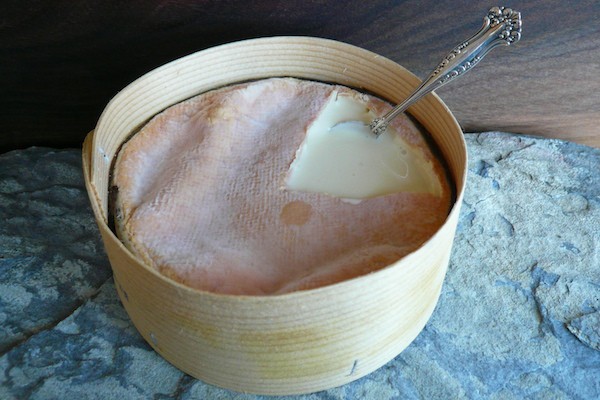
Wrapping cheeses in leaves or bark is a tradition as old as cheesemaking itself. Practical, aesthetic, and flavorful, these natural wrappers look super cool on a cheese plate and can affect the flavor profile in interesting and unexpected ways. Especially as domestic cheesemakers take interest in these quirky stylings, it can be tough not to lose the cheese-forest for all of these tree-wrapped-cheeses.
The Original

As with many things cheese, these wrappings have historical roots in France. In the case of bark wrappings, Vacherin Mont d’Or has been around the block a few times. Granted AOC status in 1981, this cheese must be aged on the eponymous golden mountain for three weeks in the winter at a temperature of no greater than 59°F. But don’t start waxing poetic—Vacherin Mont d’Or originated as an inferior product cheese. Alpine dairymen used their off-season milk to make cheese for their families. This winter milk was less desirable but extremely concentrated due to the seasonal drop in production. The high levels of fat and protein made the milk more of a goo, which the farmers then aged in spruce bark. They found an unexpected product, however, full of woodsy, resiny flavors they had never encountered before. Centuries later, you’ll have to pay a steep price to get your hands on that golden mountain cheese.

Leaves, in contrast, were a go-to traditional way to protect maturing cheeses. Similar to ash-rind cheeses, leaves were a readily available barrier for rustic cheesemakers. Many French cheeses used chestnut leaves, and a lot of these traditions have persisted to the present. A great example is Banon cheese, which gained its AOC status in 2003. Banon makers gather their chestnut leaves in autumn, and the maturing cheese may benefit from summer savory, thyme or bay leaves as well. Because of the warm climate of southern France, the cheese traditionally coagulates rapidly. The entire process of renneting, cutting the curd, and putting the unripened cheese in molds happens in just a few hours. Like most leaf-wrapped cheeses, the leaves are only applied after 5-10 days of salting and drying the cheese. In traditional cheeses, the leaves add flavor during maturation, but they also allow cheeses to be safe and survive storage in volatile climates. Leaves are generally washed in eau-de-vie to remove impurities.
What are my options outside of France?
Fortunately, leaf and bark wrappings are increasingly popular for American cheeses, and they are a wonderful source of terroir—many cheesemakers are successfully incorporating local flora through wrappings. Even if the effect at times can be more aesthetic than flavorful, it’s still a great distinctive feature for a cheeseboard. Here are a few options that wouldn’t require bribing your monger!
O’Banon is a riff on the original Banon made by the long established Capriole Goat Cheese in Indiana. Rather than eau-de-vie, owner Judy Schad soaks the leaves in bourbon, imparting aromatic hints and bright citrus flavors.
An interesting interpretation comes from Hoja Santa. Rather than chestnut leaves, theMozzarella Company from Texas uses hoja leaves after the Oaxacan tradition for wrapping chicken and fish. Tasting notes include vegetal, mint, and pepper tones that become stronger over time. Founder Paula Lambert also recommends heating the wheel still in the leaves before cutting it, allowing for it to ooze out over the plate.
We’ve discussed Winnimere on multiple occasions before, so we’ll leave other bark wrapped cheeses some page space. Harbison is another stunner from Jasper Hill Farm, wrapped in spruce like our friends on Mont d’Or—and 1st Place winner of Soft-Ripened Cow’s Milk Cheese and 2nd place Best in Show at this year’s American Cheese Society Judging and Competition! The wrapping comes from the woods surrounding the Jasper Hill cheese caves, bringing a taste of Vermont wherever you eat it. Herbaceous and creamy, Harbison is spooned out of the rind and goes amazing with a fresh baguette. Or anything, really. Add stone-ground mustard or fruit preserves to throw in some contrast.





